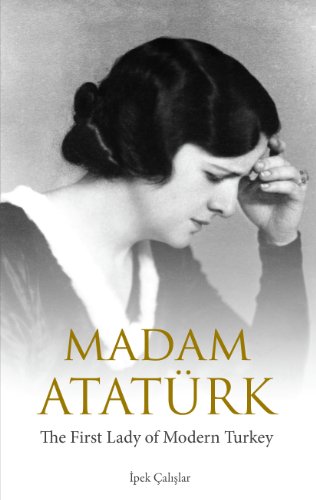
“Behind every great man is a strong woman” – so goes the old saying. Unfortunately, many of these strong women have been air-brushed out of the history books.
by İpek Çalışlar, translated into English by Feyza Howell
Book Review by Harvey TORDOFF
Even westerners with scant knowledge of the area will probably think of Atatürk as the founder of modern Turkey, but how many will know that for a brief time he was married – and that his wife helped shape his modernistic reforms? It is likely that few will know the name Latife Hanim, but then again – few will know that before adopting the new surname Atatürk was known as Mustafa Kemal.

The author of this book, which she has called Madame Atatürk (although that is a name never used by the wife of Atatürk ) does Latife Hanim and History a great service by providing the context for Kemal’s social revolution. The couple met towards the end of the Turkish War of Independence (1919-1923), in which Kemal played a pivotal role in defeating the European invaders (Greece and Armenia). But having reclaimed Turkey from foreign rule, Kemal also wanted to free his country from the old-fashioned ways by introducing modern, western ideas.
Latife Hanim, for her part, was a modern woman. She had been educated in Europe, and was well aware of women’s movements there and in the USA and Russia. She wanted Turkish women to be liberated, and she was just the woman Kemal needed by his side. Although he would later deny it, the evidence suggests they were in love with each other and they soon married. Latife accompanied the new President as he toured the country, without the traditional headscarf. Where previously there had been almost total segregation of the sexes in politics, religion, social and public life, provincial dignitaries now felt under pressure to include their wives in gatherings to welcome Kemal. And the wives in following the example shown by Latife were emboldened to be more liberated in their dress.
Latife’s knowledge of European languages and current affairs were invaluable to Kemal, who was having to change rapidly from revolutionary soldier to statesman. She would pore over the newspapers and highlight and translate the articles that she thought would be of most interest to her husband. They debated together, and she helped him compose his speeches.
So what went wrong? Why did their marriage end in divorce after two and a half years? Latife was accused of being a spoiled rich girl, but her devotion to her older husband was undeniable. Perhaps if we regard them both as passionate revolutionaries then we might see that clashes were inevitable, and after Kemal’s heart attack Latife’s dedication to his health became unbearable for the old soldier. She tried to stop him drinking, smoking, and staying up all night talking to his friends.
If divorce was inevitable, it is rather sad to note that despite their grand plans for social reform Kemal fell back on the old Turkish custom and made a simple announcement. One month later, the new law came into effect that would have given Latife a say in divorce proceedings. Perhaps Kemal couldn’t risk putting Latife on a public stage where she could provide details of their marriage. He had nothing to fear in that regard. Latife swore never to speak of their marriage, a vow she kept to her dying day.
There is no doubt that Mustafa Kemal Atatürk did much to modernise Turkish society. But how much more could he have achieved had Latife remained by his side?
20 February 2019
– Posted on February 25, 2019.
The U.S. Turkish Library & Museum Project is under The Light Millennium Organization, Associated with the Department of Global Communications of the United Nations (formerly #UNDPINGO). https://turkishlibrary.us | http://www.isikbinyili.org | http://www.lightmillennium.org